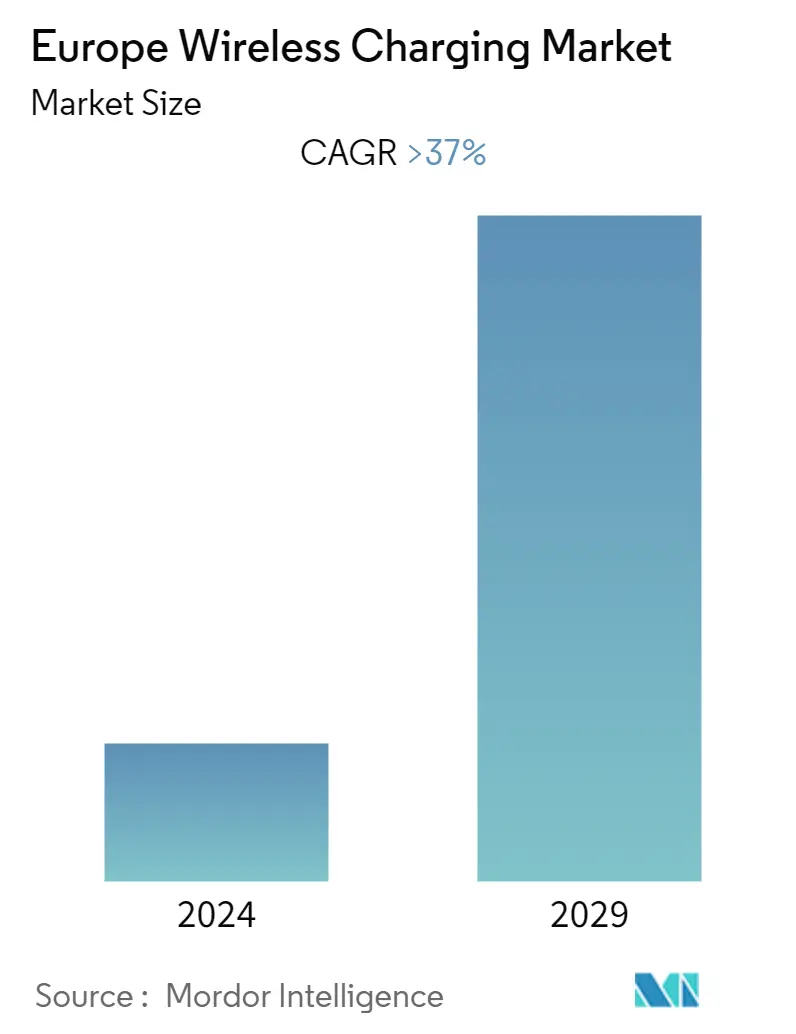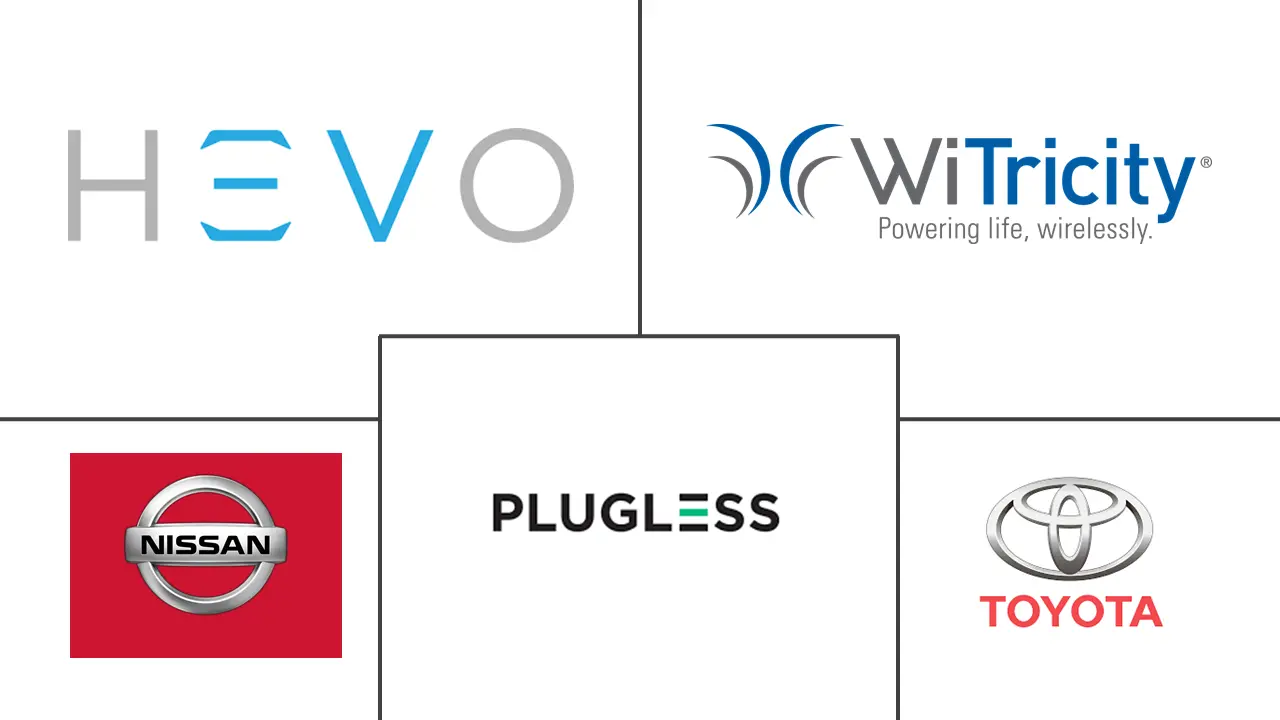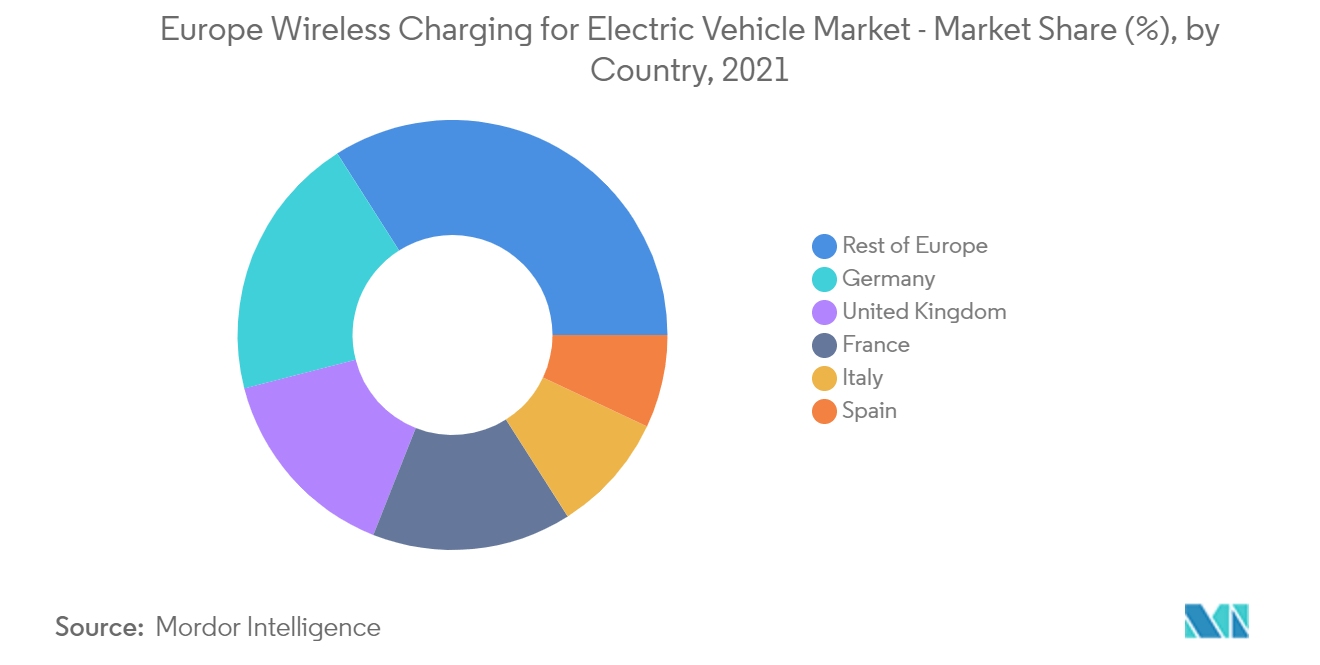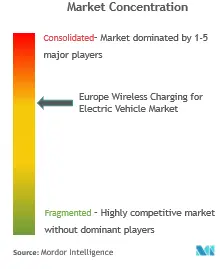Europe Electric Vehicle Wireless Charging Market Size

| Study Period | 2019 - 2029 |
| Base Year For Estimation | 2023 |
| Forecast Data Period | 2024 - 2029 |
| Historical Data Period | 2019 - 2022 |
| CAGR | 37.00 % |
| Market Concentration | High |
Major Players
*Disclaimer: Major Players sorted in no particular order |
Europe Electric Vehicle Wireless Charging Market Analysis
Europe Wireless Charging for Electric Vehicle Market was valued at USD 1.06 billion in 2021, and it is expected to reach USD 17 billion by 2027, and is anticipated to register a CAGR of 37% during the forecast period (2022-2027).
The COVID-19 pandemic has negatively affected the EV charging market due to the lockdowns and travel restrictions imposed by the governments worldwide. This has further hindered the market growth by reducing the sales of both passenger and commercial electric vehicles. With low or almost no sales registered, the potential usage of charging networks has come down by almost 80%. The wireless charging industry for electric vehicles, which was already in a nascent stage, was badly affected by the pandemic. The development of infrastructure for the charging stations hindered by the lockdown further worsened the market conditions.
Over the long term, Wireless charging is an emerging technology, which allows a vehicle to charge without plugging into a charging station. A wireless charging system consists of a ground pad that lies beneath a parked vehicle and a receiving system embedded into the underside of the PEV that connects to the vehicle's power electronics and battery systems.
- Wireless charging is one of the best solutions available for fast electric vehicle charging. However, there are major challenges in this technology, such as increasing the wireless power transfer (WPT) range with an acceptable efficiency level.
- Design and optimization of resonators play a major role in improving the system's performance in the extended range. The frequency limit of high power WPT system has been increasing rapidly with the advent of modern semiconductor technologies, such as wideband gap devices. Therefore, factors, such as cost-effective, high-power, and near MHz WPT, may be the next step of WPT for EV charging.
- Government policies played a huge role in promoting electric vehicles. The results can be witnessed in many European countries, where electric vehicles have occupied a significant portion of the total vehicle population. Norway and France are positioned to take the leading roles in the electric vehicle industry, owing to the supporting government policies.
Europe Electric Vehicle Wireless Charging Market Trends
This section covers the major market trends shaping the Europe Wireless Charging Market according to our research experts:
Increasing Sales of Electric Vehicles Driving the Wireless Charging Demand
Despite the COVID-19 pandemic, electric mobility surged across Europe, as both plug-in vehicles and battery electric vehicles accounted for a huge number of vehicle sales in 2021.
Approximately more than 1,045,000 units of plug-in EVs were registered in Europe in 2021. Out of the total EVs sold in the region, around half (51.5%) were battery electric vehicles (BEVs), with Renault Zoe, Tesla Model 3, and Volkswagen ID.3 being the top selling BEVs. This upsurge in e-mobility is mostly due to the new passenger car emission targets set for the automakers from 2020.
Major automakers, like Porsche and Audi, have introduced their line-up of electric vehicles from 2019 through 2021. For instance, Porsche launched its first fully electric vehicle, the Sportback version of the same was added to the product line-up in mid-2020. Skoda's first electric car is not expected to go on sale by 2021. Ford revealed its all-electric Mustang Mach E in Oslo, Norway, in 2019, which went on sale in mid-2020.
Such activity reported in the electric vehicles market and the increasing investments into charging infrastructure indicate good opportunities for the wireless charging market.

Germany is Leading the Electric Vehicle Demand in Europe
Most large EV markets in the European region usually have an even split between two types of EVs (PHEV and EV). Germany accounted for a good share of EVs, by registering 3 times the volume of BEVs in 2021 compared to 2020.
France accounted for the sales of 186,000 units of electric vehicles in 2020, of which the majority were registered as BEVs. The French preference for BEVs is explained by Renault's consistently best-selling model "Zoe" in the country, since 2013, with more than 37,000 units sold in 2020.
The total number of public charging stations across the region was at more than 225,000 points in 2021. A total of more than 60,000 new charging points were installed in 2021, expanding the char ging network by 37%. Although the network of charging stations is huge, it could not keep up with the increasing demand for charging the new electric vehicles in the region. Thus, the wireless charging market is expected to have a huge growth potential to serve the needs of the European market by filling the gap between demand and supply for charging infrastructure, while constantly upgrading the existing large network of charging stations across the region.

Europe Electric Vehicle Wireless Charging Industry Overview
The European wireless charging for the electric vehicle market is consolidated in nature. However, the emergence of new start-ups, such as Meredot and HEVO Power, is making the market more competitive. As a result, companies are investing in R&D projects to provide the best wireless charging technology. For instance,
- In February 2021, ElectReon, Israel, was selected to provide road charging technology for a project funded by the Roads Innovation Program of the German Federal Highway Research Institute. This technology works with wireless dynamic charging technology.
Europe Electric Vehicle Wireless Charging Market Leaders
-
Plugless
-
WiTricity
-
Nissan
-
Toyota
-
HEVO Power
*Disclaimer: Major Players sorted in no particular order

Europe Electric Vehicle Wireless Charging Market News
- In June 2020, Jaguar announced a collaboration with NorgesTaxi AS and the City of Oslo to build a wireless, high-powered charging infrastructure for electric taxis in the Norwegian capital.
- In May 2020, HEVO to Launch US Manufacturing for Wireless Electric Vehicle Charger by 2024.
- In March 2020, Electreon announced the successful completion of testing a dynamic wireless charging of a 40-ton long-haul electric truck in Sweden. This marked the world's first truck operations on a public wireless electric road.
Europe Electric Vehicle Wireless Charging Market Report - Table of Contents
1. INTRODUCTION
- 1.1 Study Assumptions
- 1.2 Scope of the Study
2. RESEARCH METHODOLOGY
3. EXECUTIVE SUMMARY
4. MARKET DYNAMICS
- 4.1 Market Drivers
- 4.2 Market Restraints
-
4.3 Industry Attractiveness - Porter's Five Force Analysis
- 4.3.1 Threat of New Entrants
- 4.3.2 Bargaining Power of Buyers/Consumers
- 4.3.3 Bargaining Power of Suppliers
- 4.3.4 Threat of Substitute Products
- 4.3.5 Intensity of Competitive Rivalry
5. MARKET SEGMENTATION
-
5.1 By Vehicle Type
- 5.1.1 Battery Electric Vehicle
- 5.1.2 Plug-in Hybrid Vehicle
-
5.2 By Country
- 5.2.1 Germany
- 5.2.2 United Kingdom
- 5.2.3 Italy
- 5.2.4 France
- 5.2.5 Spain
- 5.2.6 Rest of Europe
6. COMPETITIVE LANDSCAPE
- 6.1 Vendor Market Share
-
6.2 Company Profiles*
- 6.2.1 BMW AG
- 6.2.2 Plugless
- 6.2.3 Qualcomm
- 6.2.4 WiTricity
- 6.2.5 Nissan
- 6.2.6 Toyota
- 6.2.7 Hella Aglaia Mobile Vision
- 6.2.8 Daimler
- 6.2.9 Tesla Motors
- 6.2.10 Bombardier
- 6.2.11 OLEV Technologies
- 6.2.12 HEVO Power
7. MARKET OPPORTUNITIES AND FUTURE TRENDS
** Subject To AvailablityEurope Electric Vehicle Wireless Charging Industry Segmentation
Wireless electric vehicle charging stations (WEVCS) technology is charging an electric car without involving cables that are directly related to the vehicles system. Wireless charging is done without a connector.
The European wireless charging for electric vehicle market is segmented by vehicle type (battery electric vehicle and plug-in hybrid vehicle) and country market is segmented (Germany, United Kingdom, Italy, France, Spain, and Rest of Europe).
The report offers market size and forecast in volume and value (USD billion) for the above-mentioned segments.
| By Vehicle Type | Battery Electric Vehicle |
| Plug-in Hybrid Vehicle | |
| By Country | Germany |
| United Kingdom | |
| Italy | |
| France | |
| Spain | |
| Rest of Europe |
Europe Electric Vehicle Wireless Charging Market Research FAQs
What is the current Europe Wireless Charging Market size?
The Europe Wireless Charging Market is projected to register a CAGR of greater than 37% during the forecast period (2024-2029)
Who are the key players in Europe Wireless Charging Market?
Plugless, WiTricity, Nissan, Toyota and HEVO Power are the major companies operating in the Europe Wireless Charging Market.
What years does this Europe Wireless Charging Market cover?
The report covers the Europe Wireless Charging Market historical market size for years: 2019, 2020, 2021, 2022 and 2023. The report also forecasts the Europe Wireless Charging Market size for years: 2024, 2025, 2026, 2027, 2028 and 2029.
Wireless EV Charging in Europe Industry Report
Statistics for the 2024 Wireless EV Charging in Europe market share, size and revenue growth rate, created by Mordor Intelligence™ Industry Reports. Wireless EV Charging in Europe analysis includes a market forecast outlook to 2029 and historical overview. Get a sample of this industry analysis as a free report PDF download.



